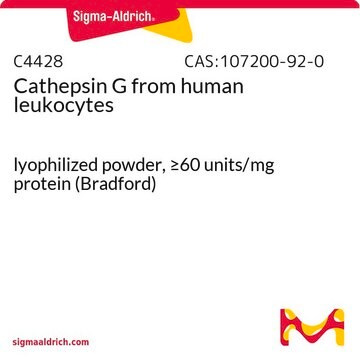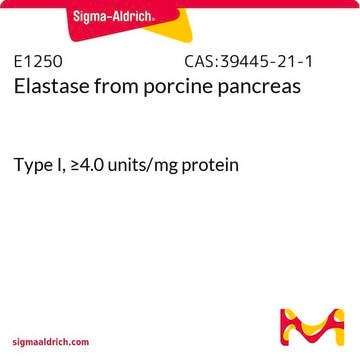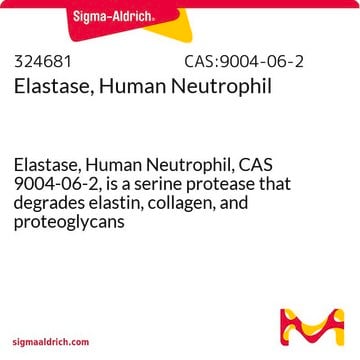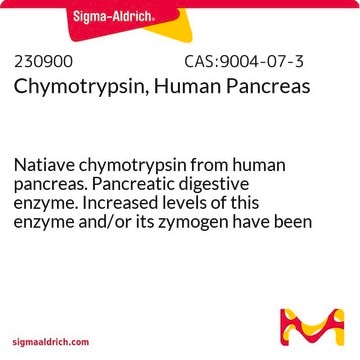Lot-specific information can be found on the certificate of analysis (COA). For example, for lot #: 3952706, the specific activity is 3.0 U/mgP, and the pack size is 100 milliunits, which is equivalent to 0.1 units. Therefore, for this specific lot, there is 0.033 mg of protein. In general, for this material, each mg is about 2 to 4 units, so 100 milliunits or 0.1 unit is equivalent to about 0.025 to 0.05 mg amount of protein.
219373
Cathepsin G, Human Neutrophil
Cathepsin G, Human Neutrophil, CAS 107200-92-0, is a purified native cathepsin G. Acts as a potent agonist of human platelet activation leading to their aggregation.
Sinônimo(s):
Cathepsin G, Human Neutrophil
About This Item
Produtos recomendados
fonte biológica
human neutrophils
Nível de qualidade
descrição
Merck USA index - 14, 1905
Ensaio
≥95% (SDS-PAGE)
Formulário
lyophilized solid (Salt-free)
atividade específica
≥2 units/mg protein
fabricante/nome comercial
Calbiochem®
condição de armazenamento
OK to freeze
técnica(s)
inhibition assay: suitable
adequação
suitable for molecular biology
aplicação(ões)
life science and biopharma
Condições de expedição
ambient
temperatura de armazenamento
−20°C
Informações sobre genes
human ... CTSG(1511)
Descrição geral
Cathepsin G is stored in its active form in azurophil granules of neutrophils or monocytes. Its mature form contains one potential glycan-binding site and three disulfide bonds.[1]
Aplicação
Ações bioquímicas/fisiológicas
Advertência
Definição da unidade
Nota de preparo
Reconstitute in 150 mM NaCl, 50 mM sodium acetate buffer, pH 5.5.
Reconstituição
Outras notas
Shamamian, P., et al. 2001. J. Cell Physiol.189, 197.
Groutas, W.C., et al. 1993. Biochem. Biophys. Res. Commun.197, 730.
Stone, P.J., et al. 1993. Biochem. Biophys. Res. Commun.197, 130.
Groutas, W.C., et al. 1992. Arch. Biochem. Biophys.294, 144.
Maison, C.M., et al. 1991. J. Immunol.147, 921.
Travis, J. 1988. Am. J. Med.84, 37.
Informações legais
Código de classe de armazenamento
11 - Combustible Solids
Classe de risco de água (WGK)
WGK 3
Ponto de fulgor (°F)
Not applicable
Ponto de fulgor (°C)
Not applicable
Certificados de análise (COA)
Busque Certificados de análise (COA) digitando o Número do Lote do produto. Os números de lote e remessa podem ser encontrados no rótulo de um produto após a palavra “Lot” ou “Batch”.
Já possui este produto?
Encontre a documentação dos produtos que você adquiriu recentemente na biblioteca de documentos.
-
Could you please provide the item number for R: 219373? I recently purchased Human Neutrophil Cathepsin G (219373) with a concentration of 100MIU. I'm experiencing difficulty converting it to µg/ml for the required dilution. Can you assist me with this? Thank you.
1 answer-
Helpful?
-
Active Filters
Nossa equipe de cientistas tem experiência em todas as áreas de pesquisa, incluindo Life Sciences, ciência de materiais, síntese química, cromatografia, química analítica e muitas outras.
Entre em contato com a assistência técnica







